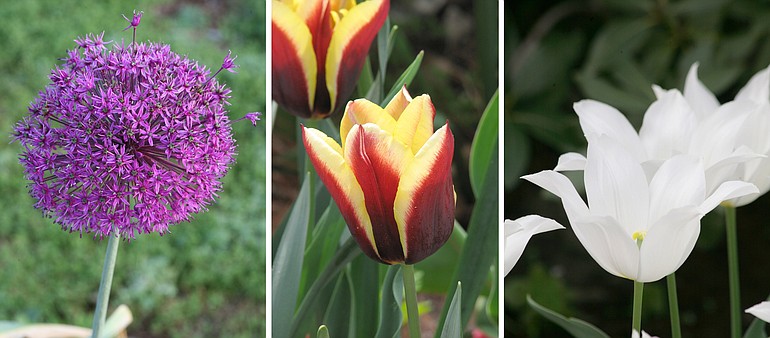Consider this next time you’re on your knees with a trowel in the fading fall garden: It takes as much effort to plant a mediocre spring bulb as it does a superior one.
Fabulous varieties of bulbs may cost a little more than the usual fare, but the reward is worth it. To me, better bulbs are ones that are novel, long-flowering, elegant, beautiful and, where possible, fragrant.
Appearing when the garden is beginning to grow and lift our winter spirits, these beauties elevate the experience to an even higher plane.
The smaller the garden, the more considered the bulb choice should be. This is particularly so in the tiniest of gardens: containers. Spring bulbs, by the way, do well in containers, and the bigger the pot, the better. Just make sure it drains and is not a type that will crack with winter freezes and thaws.
If I were limited to just a dozen easily found varieties, these are the ones I would pick, knowing they would have enough variation and quality to satisfy my spring bulb cravings.
Daffodils
Daffodils come back year after year, and deer and squirrels leave them alone. The daffodil world is amazingly diverse. The best are among the most sublime of any garden flower. I have an aversion to daffodils with double flowers; there seem to be more of them each year, alarmingly.
Daffodils with the largest coronas, or cups, are called trumpets. I find most of them too coarse, especially the yellow varieties King Alfred and Carlton. Honeybird is a subtle lemon yellow and worth a look, but if you step down in size to a class called large-cupped daffodils, you enter a world where the daffodil nears perfection: The cup is in a more pleasing proportion to the surrounding perianth (petals) and there are many colorful varieties that stand tall.
Ice Follies is overplanted, though handsome, so I’d rather go with something more unusual, such as Ceylon. It has buttercup-yellow petals and a red-orange cup. The bloom holds its head high and is tough against rain, wind and sun. Plant a few in a drained, sunny location, and expect double the flowers in a few years.
To me, the pinnacle of narcissus elegance is a variety with a white perianth and rose-pink cup, and a great example of this is Fragrant Rose. Plant it where you can get down and smell it. You should smell all spring bulbs; you’d be amazed how many are scented.
Small daffodils do not consist solely of indoor paperwhites (though they have their place in the dark hollow of February), and some of the most charming diminutive bulbs of spring are not crocus or squill but daffodils. I adore Hawera, which produces a cluster of cheerful pale yellow blooms six inches high, nodding, and great in the company of other delicate April flowers, such as grape hyacinths and creeping phlox.
The poet daffodils are tall and showy, but with full, rounded white petals and delicate, orange-yellow cups. They bloom late, seeing out a daffodil season that can last six weeks. I prefer a variety named Actaea: Its cup is rimmed red and the flower looks great in the garden or the vase.
Tulips
Depending on climate, tulips might wither after a season or produce nonflowering growth the following year. Unless they are reliably perennial bloomers, I just yank them out after flowering and thank them for their show. Their ability to add so much to the young, naked April garden makes them a cheap extravagance.
Some of the loveliest do return year to year: varieties of a species named clusiana, the candy-stripe tulip. The flowers are pink and white, or rose pink and soft yellow, and held aloft on slender stems. They need a sunny site and good drainage to endure and flourish. My favorite is Lady Jane, taller and whiter than most with a rose-pink outer petal.
Princess Irene, or Prinses Irene, is a classic scented early tulip favored for its unlikely colors: orange with purple flames licking up the petals. I’ve seen it paired creatively with dark purple tulips, orange or violet pansies, even purple beet greens.
Gavota is a dramatic mid-season triumph tulip, sporting showy pointed petals with deep burgundy centers and rich yellow edges. It is striking in form and color, particularly when planted in a mass.
Certain tulips can bring a calm serenity amid the chaos of spring. For years, I grew a single late tulip named Maureen for this effect. It forms a robust, creamy chalice in late April. In recent years, I’ve assigned that role to a white lily-flowering tulip named White Triumphator. It is a classy bulb, angelic above the stirrings of perennials and ground covers.
My other favorite lily-flowered tulip is the orange Ballerina. Orange is underused in the garden because it can clash awfully with spring’s abundant pink and magenta hues. But it pairs well with flowers in blue, violet and purple — such concurrent bloomers as pansies, grape hyacinth, squill, cranesbill Ingwersen’s Variety, and the phlox Sherwood Purple.
Specialty bulbs
This is a catchall class that covers everything from the first tiny bulbous iris to the grandiose Crown Imperial, a one-spring wonder of a fritillaria that costs about $6 a bulb. The more demure, minor bulbs can be supremely elegant. I’m thinking of snowdrops, scilla, glory-of-the-snow and crocus, for example, but you have to plant them by the hundreds, if not the thousands, for them to have any sort of landscape effect. But just a few ornamental onions can give a real punch in early May while bridging a little lull in the spring action. They are basically great big lollipops, and I particularly like Purple Sensation, not the biggest but with a rich violet purple globe.



